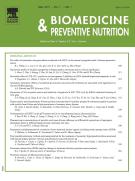Efficacy of curry (Murraya koenigii) leaves in scavenging free radicals in vitro and controlling oxidative stress in vivo - 26/11/11
 , Mahalakshmi Shankaran, Rajeshwari Ullagaddi, Vinay Kumar Allagadda
, Mahalakshmi Shankaran, Rajeshwari Ullagaddi, Vinay Kumar AllagaddaAbstract |
Efficacy of curry (Murraya koenigii) leaves was investigated in scavenging free radicals in vitro and controlling oxidative stress in vivo. Ethanolic extract of curry leaves (Murraya koenigii) was tested for the antioxidant activity in vitro using butylated hydroxy toluene as positive control. Erythrocyte membrane of human volunteer was used as peroxidation model system in vitro while aged human volunteers served as subjects for in vivo assessment. Curry leaf extract displayed scavenging activity against radicals viz. 2,2-diphenyl-1-picrylhydrazyl (DPPH), nitric oxide and superoxide in a concentration dependent manner and inhibited FeSO4-induced lipid peroxides and hydroperoxides in erythrocyte membrane model. This is supported by significantly decreased lipid peroxidation in plasma and erythrocytes, significantly elevated levels of non enzymatic antioxidants (β-carotene, vitamin A, C & E) in serum and significantly decreased activity of catalase, elevated activities of superoxide dismutase and glutathione-s-transferase and raised reduced glutathione (GSH) in erythrocytes in curry leaves-treated aged subjects. In conclusion, curry leaves possess antioxidant properties and the effect is a result of synergistic action of antioxidant phytochemicals, i.e., carotenoids, flavonoids, oleoresins etc. present in the leaves. The findings of this study suggest that the leaves may be prescribed as adjunct to dietary therapy for controlling oxidative stress that causes chronic diseases in elderly.
Le texte complet de cet article est disponible en PDF.Keywords : Curry leaves, Antioxidant potential, Lipid peroxidation
Plan
Vol 1 - N° 4
P. 263-267 - octobre 2011 Retour au numéroBienvenue sur EM-consulte, la référence des professionnels de santé.
L’accès au texte intégral de cet article nécessite un abonnement.
Déjà abonné à cette revue ?

